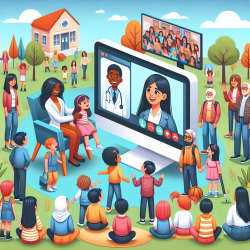Introduction
In the realm of speech-language pathology, especially in online therapy settings such as those provided by TinyEYE, understanding and leveraging community dynamics can significantly enhance therapeutic outcomes. A recent study titled “They have their security, we have our community”: Mutual support among people experiencing homelessness in encampments in Toronto during the COVID-19 pandemic provides insightful findings that can be applied to our practice.
Understanding Mutual Support
The study highlights how mutual support systems within encampments helped residents meet basic survival needs and fostered a sense of community. This mutual support was crucial in addressing health and safety risks and providing emotional and instrumental support. As speech-language pathologists, we can draw parallels to the therapeutic environments we create, whether in-person or online.
Application in Speech-Language Pathology
Here are some key takeaways and how they can be applied in our practice:
- Community Building: Just as encampment residents formed supportive communities, therapists can foster a sense of community among children and their families. This can be achieved by encouraging peer interactions and creating group therapy sessions that allow children to support each other.
- Peer Support: The study shows that peer support is instrumental in improving outcomes. In therapy, facilitating peer support can enhance learning and motivation. Children often learn effectively from peers, and creating opportunities for them to teach and support each other can be beneficial.
- Addressing Diverse Needs: The encampment study highlights the importance of addressing diverse needs through mutual support. In therapy, understanding each child's unique needs and encouraging a supportive environment where children help each other can lead to better outcomes.
Encouraging Further Research
While the study provides valuable insights, it also opens avenues for further research in speech-language pathology. Exploring how mutual support systems can be integrated into therapy settings, especially online, can be a fruitful area of study. Researchers and practitioners should consider investigating the impact of peer support and community dynamics on therapy outcomes.
Conclusion
The findings from the encampment study underscore the power of community and mutual support. As speech-language pathologists, embracing these principles can enhance our practice and lead to better outcomes for the children we serve. By fostering supportive environments, encouraging peer interactions, and addressing diverse needs, we can create a more effective and inclusive therapy experience.
To read the original research paper, please follow this link: “They have their security, we have our community”: Mutual support among people experiencing homelessness in encampments in Toronto during the COVID-19 pandemic.










